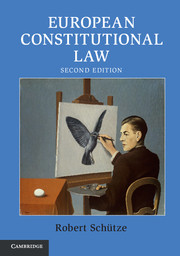Book contents
- Frontmatter
- Dedication
- Summary Contents
- Contents
- List of Illustrations
- List of Tables
- List of Cases
- List of Secondary Law
- Table of Equivalents
- List of Abbreviations
- Acknowledgements
- Introduction: European Constitutional Law
- Part I Constitutional Foundations
- 1 Constitutional History: From Paris to Lisbon
- 2 Constitutional Nature: A Federation of States
- 3 European Law I: Nature – Direct Effect
- 4 European Law II: Nature – Supremacy/Pre-emption
- 5 Governmental Structure: Union Institutions I
- 6 Governmental Structure: Union Institutions II
- Part II Governmental Powers
- Appendices
- Index
- References
2 - Constitutional Nature: A Federation of States
from Part I - Constitutional Foundations
- Frontmatter
- Dedication
- Summary Contents
- Contents
- List of Illustrations
- List of Tables
- List of Cases
- List of Secondary Law
- Table of Equivalents
- List of Abbreviations
- Acknowledgements
- Introduction: European Constitutional Law
- Part I Constitutional Foundations
- 1 Constitutional History: From Paris to Lisbon
- 2 Constitutional Nature: A Federation of States
- 3 European Law I: Nature – Direct Effect
- 4 European Law II: Nature – Supremacy/Pre-emption
- 5 Governmental Structure: Union Institutions I
- 6 Governmental Structure: Union Institutions II
- Part II Governmental Powers
- Appendices
- Index
- References
Summary
Introduction
The rise of the modern State system after the seventeenth century was a celebration of political pluralism. Each State was entitled to its own ‘autonomous’ existence.
The rise of the absolute idea of State sovereignty led to an absolute denial of all supranational authority above the State. This way of thinking introduced a distinction that still structures our understanding of the legal world: the distinction between national and international law. The former was the sphere of subordination and compulsory law; while the latter constituted the sphere of coordination and voluntary contract. International law was thus not ‘real’ law – as it could not be enforced. From the perspective of classic international law, a ‘public law’ between sovereigns was thus a contradiction in terms since it required an authority above the States; but if sovereignty was the defining characteristic of the modern State, there could be no such higher authority. All relations between States must be voluntary and, as such, ‘beyond’ any public legal force.
From the very beginning, this traditional idea of State sovereignty blocked a proper understanding of the nature of the European Union. The latter was said to have been ‘established on the most advanced frontiers of the [international] law of peaceful cooperation’; and its principles of solidarity and integration had even taken it ‘to the boundaries of federalism’. But was the Union inside those federal boundaries or outside them? For while the European Union was not a Federal State, had it not assumed ‘statist’ features and combined – like a chemical compound – international and national elements? But how should one conceptualise this ‘middle ground’ between international and national law? In the absence of a federal theory beyond the State, European thought invented a new word – supranationalism – and proudly announced the European Union to be sui generis. The Union was declared to be ‘incomparable’; and the belief that Europe was incomparable ushered in the dark ages of European constitutional theory. Indeed, the sui generis idea is not a theory. It is an anti-theory, for it refuses to search for commonalities; yet, theory must search for what is common among different entities.
How, then, should we view and analyse the nature and structure of the European Union? This chapter presents two answers to this question by looking at two different constitutional traditions.
- Type
- Chapter
- Information
- European Constitutional Law , pp. 43 - 76Publisher: Cambridge University PressPrint publication year: 2015



